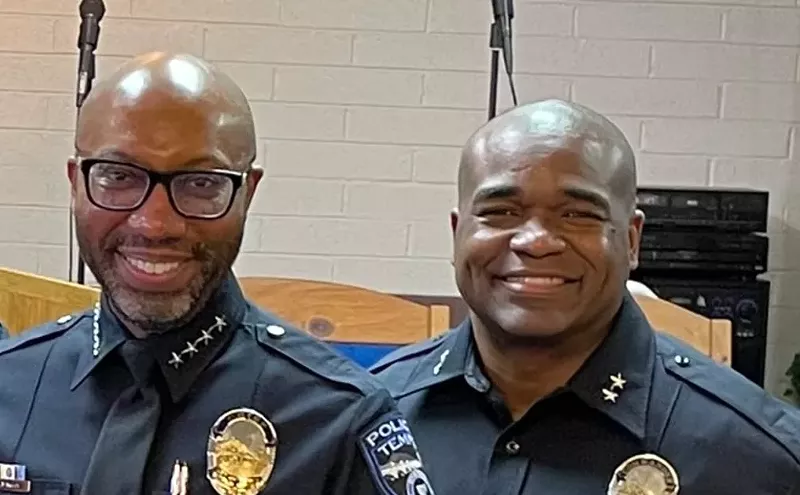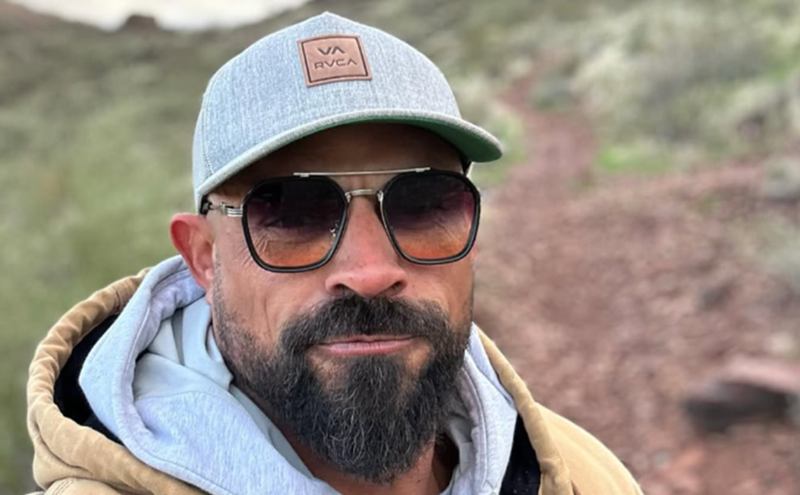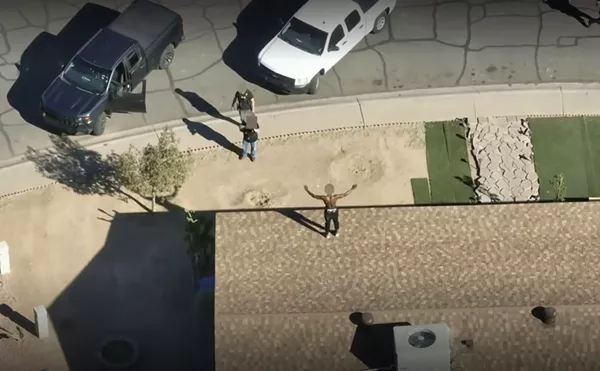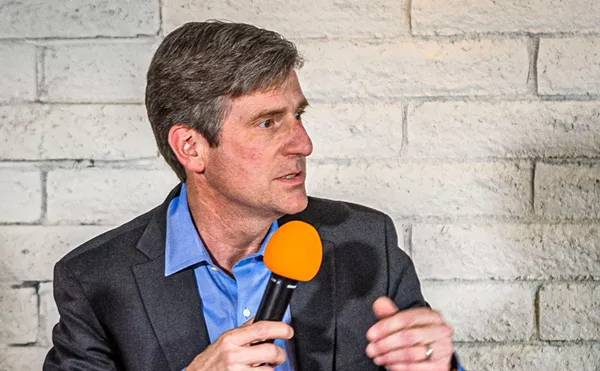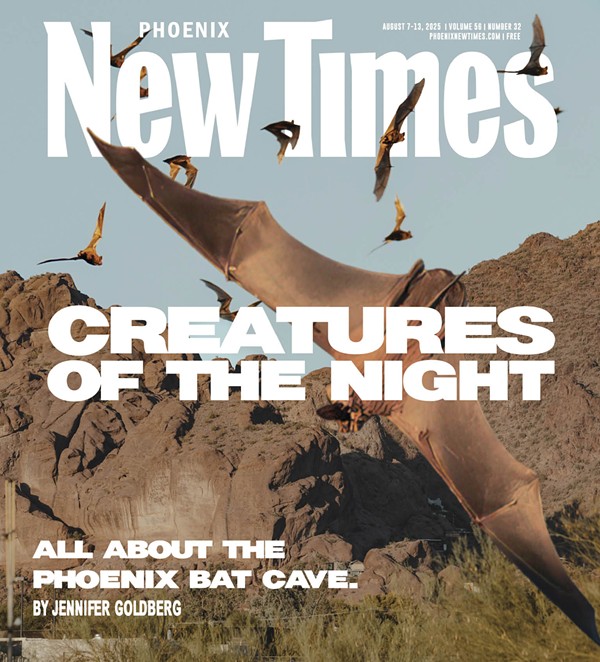Tempe’s historic Double Butte Cemetery is one of the area’s oldest, dating back to the 1890s, before Arizona was a state.
One section of the 17-acre property near 48th Street and Broadway Road is lush and green, lined with trees beneath which visitors might spy local fauna, rabbits, or an indigenous kit fox on the prowl.
But no shade shields the desert grave of Hells Angel Robert “Chico” Mora. In death, he resides in what seems to be the cemetery’s cheap seats, an area up against the butte where no grass grows and where many of the graves are marked with little more than white wooden crosses.
Mora, who died January 1, 2014, at age 58 of complications from diabetes, has a flat stone marker engraved with two fearsome winged skulls facing each other: a double image of the outlaw biker group’s trademarked emblem.
At the bottom of the headstone are the letters “AFFA,” short for the motto, “Angels Forever, Forever Angels.”
Robin Green, the last of Mora’s official “ol’ ladies,” as a principal girlfriend is called in the biker world, looks down at Chico’s grave and weeps.
“I wish there was some shade,” she tells New Times, her eyebrows scrunched in a look of worry. “It’s kind of out here in the middle of the rubble, but Chico wanted to be buried next to Boomer.”
That’s fellow Angel Raymond “Boomer” Baker, who passed in 2011 and whose custom-made headstone easily is the most handsome of those populating this hardscrabble patch of dirt.
Green, a pixie-ish blonde better known to the biker community by her handle “Robin-eddy,” says the artist who made Boomer’s squat, beige tombstone is working on one just like it for Mora.
Visitors have left stones, coins, and other little oddities of remembrance on Mora’s marker, including a small, red plastic dragon, a reminder of Mora’s onetime ride, a 1951 Harley-Davidson “pan shovel” converted into a custom-designed chopper that Mora and everyone who knew him called the “Red Dragon.”
According to Green and artist Michael Star, who helped build the bike long ago, Mora had a vision of the Red Dragon, which Star and others helped make a reality when Mora was president of the Tucson chapter of the Dirty Dozen, an infamous club of Cain-raisin’ hooligans who ruled Arizona’s highways for nearly three decades.
Unkempt and wild, with a fearsome reputation backed by criminality, the Dirty Dozen was Arizona’s preeminent motorcycle club and would not allow other clubs to operate in the Grand Canyon State without its permission.
Its creepy black-and-white patch featuring a pair of dice with the sixes facing out and cobwebs trailing off the sides was loathed by law enforcement and known to panic ordinary bar patrons, should bikers wearing it roll up to a watering hole en masse.
Shootouts, drug use, and Rasputin-like orgies were de rigueur for the Dozen, who started biker traditions now cherished by those who consider themselves “one-percenters,” a 20th-century reference to the one percent of motorcycle enthusiasts who are not law-abiding.
The most prominent of these traditions remains the famed Florence Prison Run, begun in the early 1970s. It draws thousands of bikers every year to the small prison town for a drive-by salute to the incarcerated.
But the Dozen are no more. In 1996, the club voted to “patch over” and become Hells Angels, with those unwilling to do so forced to retire and ordered never fly the Dozen patch again.
Local Angels and their supporters say this largely was because of the incessant campaigning of Mora, a Dirty Dozen legend who dreamed of turning Arizona Red and White (the Angels’ colors) and merging his fellow members with an even larger worldwide brotherhood.
It also was a merger the Angels wanted, an expansion of their territory into a part of the country where outlaws flourish, guns have little or no restrictions, helmets are not required, and wide-open vistas and scenic beauty seem tailor-made for riding motorcycles.
Angels icon Sonny Barger had done time in the federal pen here in the 1980s and learned to love the sun and dry heat. He moved to Cave Creek from Oakland following the patch-over, making Arizona his home and recently migrating to Yavapai County.
Law enforcement agencies will note Arizona’s proximity to Mexico, making illegal trade in firearms and meth a cinch. Federal scrutiny, most famously by the U.S. Bureau of Alcohol, Tobacco, Firearms, and Explosive’s 2003 operation “Black Biscuit,” has resulted in scores of arrests and nearly as many accounts of the operation in books, magazines, and documentaries.
Consequently, the Hells Angels and Arizona have entered into a symbiotic relationship, never to be severed.
For this, one man deserves the lion’s share of credit — or blame.
On a hot Sunday in June, about 25 friends, lovers, and fellow Hells Angels dropped by Steven Edgeworth’s bucolic property in West Phoenix to swap Chico stories.
Edgeworth, a former ship’s captain in the U.S. Merchant Marine, took in Mora during the last year or so of his life, when Mora had trouble walking and was prone to blackouts from low blood sugar.
A dead ringer for actor Michael Madsen’s character, Mr. Blonde, in Reservoir Dogs, Edgeworth lives in a pre-war home that essentially is a big man cave. The walls of the front room are covered in a vast collection of swords and knives, some from the 37 countries he visited while at sea.
This room opens onto a dining area, where a pool table rarely is unoccupied, folks help themselves to a corner bar, and posters and memorabilia honoring the Frank Sinatra-led Rat Pack abound.
Edgeworth is an HA supporter and rides with them sometimes but is not a member. He explains that Mora’s last months on Earth were spent next door, in the small house beside his, where Mora played video games and cheerfully tormented his pet, a black Chihuahua named Chica Ruca.
“He’d have her hanging [by a rope] with just her feet touching the ground,” he laughs, “because she shit on his sofa or something.”
The ex-sailor, who refers to himself as “a grouchy fuck,” says he met Mora years ago in Cave Creek and they bonded over a mutual love of chess.
They were big readers as well, Edgeworth cultivating his serious reading on ship and Mora immersing himself in books during prison stints.
“I’ve always rode motorcycles and hung out with hardcore people,” Edgeworth says, “but he just oozed badass.”
Mora’s ruthlessness was storied. In 1980, he shot and killed two members of a rival club in Globe, ultimately pleading guilty to manslaughter, for which he was sentenced to five years. He did about half the time.
In prison, he trained as a boxer, reportedly becoming a Golden Gloves champion. He left prison lean and mean at a ripped 6-foot-3 and nearly 300 pounds of muscle. A monster.
While president of the Dirty Dozen’s Tucson chapter, if he caught you wearing a rival club’s “bottom rocker,” the lower third of a three-piece motorcycle “patch,” you either had to take off the rocker or Mora’d cut it off for you.
In his bestselling account of the Black Biscuit operation, No Angel: My Harrowing Undercover Journey to the Inner Circle of the Hells Angels, undercover ATF agent Jay Dobyns paints Mora, then a senior member of HA’s Phoenix charter, as one biker you didn’t fuck with.
According to Dobyns, a snitch in the employ of the ATF advised him to steer clear of the HA bruiser.
“Mesa Mike warned me never to tangle with Chico,” Dobyns wrote, “that he’d kill anyone — cop, woman, child, dog, bunny rabbit, even a Hells Angels brother if he deserved it — without losing a wink of sleep.”
As part of Black Biscuit, Dobyns and other agents passed themselves off as members of a lesser entity, the Solo Angeles, headquartered in Tijuana.
Both Dobyns’ book and others’, such as Phoenix criminal attorney Kerrie Droban’s Running with the Devil: The True Story of the ATF’s Infiltration of the Hells Angels, report that the ATF believed Mora was, according to Droban, “assembling a hit squad of old-school Hells Angels, former Dirty Dozen members, to take out the Solo Angeles.” (Note: HA members and associates deny this part of Black Biscuit lore.)
At the time, Mora did not know the Solo Angeles were undercover cops. He was just pissed that they were operating in his territory.
The supposed plot brought a premature end to Black Biscuit, a bold if flawed operation that resulted in a June 2003 raid’s jacking up more than 30 individuals and resulting in indictments of HA chapter presidents, members, and associates on charges related to drug and gun dealing and racketeering.
Black Biscuit bit Mora, as well. He was hit with a federal charge of possessing body armor with intent to sell, found guilty during a 2004 jury trial, and sentenced to 18 months in prison. A year later, the conviction was reversed on appeal.
Mora was not just fearsome to rival gangs or cops. Even fellow Angels risked injury if they crossed him.
During the get-together at Edgeworth’s, a mountain of a Hells Angel named “Slut Doug” Wistrom remembered the fights he and Chico had, whether between the two of them or with others.
The former Dozen member who patched over with Mora and the rest, recalls a time in Tucson when he and Mora took on a rugby team outside a bar after an exchange of words.
The rugby team caught the worst of it, according to Slut Doug’s version. One witness to the brawl described Mora’s flinging beefy rugby players off his person “like they were paper dolls.”
Though they knew each other “for like 30 years,” Mora and he occasionally would come to fisticuffs, Wistrom says.
What would they fight over?
“Fuckin’ anything,” Wistrom growls. “[Chico] thought he was always right, for sure. If I know I’m right, I’ll fucking stand.”
He recalls how he once tried to pull a Cato to Mora’s Pink Panther.
“In total fucking darkness, I jumped on him,” says Wistrom, annoyed by the memory, “right on his head, taking complete unfair advantage of the situation and still ended up [on the ground] and shit.”
Such war stories, painting Mora as a biker Paul Bunyan — part Conan the Barbarian, part Blackbeard the Pirate — goes a long way toward understanding why, when Mora was laid to rest on January 11, 2014, a cortege of more than 300 bikers ushered Mora’s massive casket, hauled by a black, Harley-pulled hearse, to the grave.
Though Sonny Barger did not respond to requests for comment for this story, witnesses state that he was present at the gravesite, where the tough-as-leather HA czar bit back a tear as he offered a eulogy.
Chico’s little sister, Clarita “Piqui” Reynolds Mora, attended the funeral, and she recalls Barger’s words.
“When he was talking,” she tells New Times during an interview from her home in Minnesota, “[Barger] said, ‘I don’t want to admit this out loud, but Chico was the only one who ever put me on my ass. And then he helped me back up.'”
The nature of the altercation is unknown, but several funeral-goers confirmed the quote as accurate.
The two men certainly respected each other. A year earlier, Barger recruited Mora to play the character Ahab in the independent film Dead in 5 Heartbeats, based on Barger’s novel of the same name.
Mora plays the president of the Oakland Infidelz, a thinly disguised version of the Hells Angels.
More than one person has noted the similarities in Ahab and Cisco Valderrama, the biker who became president of the Oakland HA after Barger left for Arizona.
Valderrama died almost exactly one month after Mora.
The oddest thing about Mora’s grave is that there is a slight rise in the earth where the plot should be flat.
This, say friends and family, is because Mora’s casket — emblazoned with the HA death’s head and (per Mora’s wishes) the phrase, “He was a cruel but fair man” — did not completely fit in the grave dug for it.
A smaller casket was placed beneath it to prop it up. Thus, Mora’s gargantuan frame is buried only three feet below ground.
Tracie Valenti, Mora’s ol’ lady before Green came into the picture, remembers watching the crane attempt to lower the casket into the hole.
“Every time it’d go in an inch above the ground,” she explains, “like he was fighting it tooth and nail, like he had hands on the sides [of the hole].”
Valenti alternates between laughter and sadness as she speaks of Mora. She’s the mother of Mora’s grown son, Chance, and she laments that Mora did not live to see Chance graduate from the University of Arizona with a B.A. in English/creative writing and with honors.
She remembers her first encounter with Mora in a Tucson club where she was a stripper. At the time, she was married to the president of the local chapter of the Devils Disciples, an enemy of Chico’s who later became a friend through Valenti.
Valenti offered the hulking Dirty Dozen member a lap dance, with a verbal shot at the Dozen’s local rivalry with the Devils.
“I told him, ‘I’m gonna charge you double to do the Devils’ strut,’” she recalls, laughing. “He said, ‘Bitch, you’re gonna pay me and do the Dozen shuffle.’”
Soon enough, she was sporting a new tattoo on her hindquarters: “Ball-licker of Chico.”
According to a prison IQ test, Mora scored 120, well above average, which apparently made him smart enough to avoid working for a living.
Though he’d been to culinary school, some say, and had dabbled in motorcycle maintenance, others say, he seemed to mostly rely on his women to keep him in the style to which he was accustomed.
“He was an iron sponge,” cracks Valenti. “I worked. He worked on taking my money. That’s about it.”
This left Mora more time for pursuits better suited to a Dirty Dozen jefe: knife-throwing practice, cracking his 30-foot whip, working on his bike, partying, illicit drug use, and battling other clubs.
His last main squeeze concurs with his second-to-last, giving an outsider a window onto the uncommon world of outlaw bikers.
“It was an honor to take care of your man,” Green says. “So much so that we worked to support them. They didn’t have to do shit.”
Green, who in the ’80s and ’90s resembled a young Traci Lords, is a sometime dancer and dominatrix by trade, used to tying grown men to a St. Andrew’s Cross and beating them black and blue.
She says she introduced Chico to the bullwhip, at which he became expert, possessing the ability to flick a lighted cigarette out of a volunteer’s mouth.
Green claims women would line up at the Dirty Dozen clubhouse in Tucson to take their place on the club’s whipping post and let Chico have at it.
“That whip lash is some kind of a mating call for women,” Green contends.
Both Green and Valenti, who are friends, described treating Chico like a feudal lord, including putting on his shoes and socks for him every day and brushing his hair.
“People might think he abused me,” says Green of those who observed the practice. “All I was doing is ‘primate grooming.’ It was something he needed.”
This was part of the Dirty Dozen lifestyle, according to Green, which was a little freer in some ways, according to her, than the Hells Angels’.
For instance, she was allowed to have boyfriends, and, of course, Chico was allowed to have multiple partners.
Indeed, it was Valenti who introduced Green to Mora.
“Tracie brought me home one night,” Green recalls, “and said, ‘Let’s see if you can suck his dick better than me, bitch.’”
Valenti says she later told Green, “Robin, you and Chico were together nine months, and I didn’t know that [Chico and me] were broken up.”
All the Dirty Dozen women were “recycled,” according to Valenti. She moved on to a guy named JoJo, one of Mora’s biker brothers.
But Mora could be violent, and this extended to his relationships with women.
Even chosen women like Valenti had no say in the club, could not enter the club without their man, and were made to wear jackets that said “Property of,” with the biker’s name on it.
“The property jacket is just so some brother of mine doesn’t go beat on my woman,” Mora told Tucson Weekly in the 1990s.
“But if we’re in a bar and she says, ‘Fuck you,’ I’ll say, ‘Fuck who?’ Pow! Yeah, I’d hit her in public,” he says, explaining that ordinary Joes could not understand.
Though Valenti remembers Mora fondly, she admits he could be both a “tyrant” and a “monster.” She recalled a time when he head-butted her and broke her nose.
“And this is when I was JoJo’s wife,” she laughs, adding, “There was blood on the wall of his house. He wouldn’t let none of them bitches [Mora’s concubines] clean it up for six years!”
Whenever Valenti started to get “out of hand,” Chico would point to the blood on the wall as a warning.
Mora and his sister Piqui were the third and fifth out of a brood of seven kids, U.S. Army brats to a dad who was militaristic and physically abusive.
With a mom who suffered from mental problems, it made for a volatile upbringing.
“It was a nightmare,” Piqui says. “That’s why my brother was the way he was.”
The kids were born all over. Mora was born in Panama, a fact the U.S. Department of Homeland Security once used (unsuccessfully) to try to have Mora deported in the 2000s.
“My brother was always angry,” Piqui says.
With a dad who disciplined them if the dishes were not done just so and a mom who, Piqui says, used to talk to the washing machine, there apparently was a lot to be angry about.
When Mora was about 18, Piqui says, their father punched Chico during a fight, and her brother told her dad that it was the last hand he would ever lay on him.
Mora left and joined a traveling carnival. He soon got in trouble with the law in Arkansas (something involving a high-speed chase, Piqui says) and Mora ended up back in Arizona.
He got into motorcycles after leaving home and one day dubbed himself “Chico” while discussing motorcycles with two other bikers, his sister says.
She believes that Chico became the menacing, brutish alter ego to the more sensitive and insecure Robert.
And when he was Chico, look out!
“He’d get a certain look in his eyes,” she says. “And it was like he was imagining what he’s going to do to you.”
Two men in Globe would discover just how dangerous Chico could be.
Mora’s rap sheet includes convictions for possession of meth, possession with intent to distribute, misconduct involving weapons, and the aforementioned body-armor conviction (reversed).
But the worst (the one that sealed his reputation as a bad-ass) was the manslaughter rap he caught in 1980 at age 24.
The crime regularly has been invoked in news stories about how the Dirty Dozen terrorized Arizona, part of a series of headlines and TV news reports involving Dozen members in everything from aggravated assault to meth-slinging to counterfeiting to murder.
In a 1993 New Times article about an effort by the Arizona Department of Public Safety to bring down the club, it seemed law enforcement was overly focused on the depravity of this hairy band of bikers.
David Pasztor wrote in the piece:
“The police say the members award each other special badges for performing oral sex on women in front of witnesses. The badges sport different colors, depending on whether the woman is white or black, menstruating or not, dead or alive.
“They buy, sell, and trade their wives and girlfriends, the police version goes, and love only their Harleys, colors, guns, and drugs.”
Former Dirty Dozen members insist the one about oral-sex patches is baloney.
Leading the task force targeting the Dozen’s debauchery was DPS Lieutenant David Gonzales, now U.S. Marshal for Arizona and a possible challenger to Maricopa County Sheriff Joe Arpaio in 2016.
Gonzales was nothing if not earnest back in 1993.
“They think about nothing but crime from the time they get up in the morning until they go to bed at night,” the lawman told Pasztor of the Dozen.
Which enhanced the reputation of the club, among criminals, at least.
In addition to the DPS, Gonzales’ task force comprised members of the FBI, the ATF, and the Phoenix and Mesa police departments.
More than 400 cops served 68 warrants on the homes of Dozen members in the state, with some bikers hauled to the state fairgrounds to be processed before news cameras.
About 40 bikes and more than 1,000 guns and knives were seized, but much of the property had to be returned, and the number of actual drug busts was disappointing, according to the article.
The raids didn’t crush the club, anymore than similar federal raids did in 1985.
Mora wasn’t mentioned in the piece, but his pal Slut Doug was, and Pasztor briefly described the club’s two most heinous incidents: One being the 1983 shooting of a Phoenix electrician, who was killed in a hail of bullets outside a local lounge.
The victim had been booted from the bar by Dozen members and chose to express his anger by running roughshod over their Harleys.
Similarly, two 27-year-old men from the Miami-Globe area, David Howell and Laird Kriley, were unfortunate enough to confront Mora in a bar near Globe.
According to a report in the Arizona Silver Belt, Howell and Kriley were members of a motorcycle club from New Mexico called Bad Company.
Tucson attorney Chuck Weninger defended Mora in 1980. Now retired and living in Costa Rica, Weninger, 66, has amazing recall of events from more than 30 years ago.
“The Dirty Dozen were trying to start a Globe chapter, and Bad Company didn’t like it,” says Weninger, a motorcycle enthusiast originally from Hungary, in a telephone interview.
Apparently, Mora had been dispatched from Tucson to Globe for this purpose. The shootout at the bar caused hysteria in the small mining community.
“Every guy with a Dirty Dozen patch got picked up,” Weninger remembers, adding, “A rumor started to pass around that there were Dirty Dozen all around the hills of Globe who were about to descend on the town.”
Eleven DD members were nabbed that weekend, though Weninger says they, and another man later arrested, had nothing to do with it.
Feeling bad for his brothers behind bars, Mora, with Weninger at his side, turned himself in to Sheriff Lyman Peace on the Monday after the shooting.
In a photo of Mora in the Silver Belt, he looks like a taller, thinner Jerry Garcia, with long hair, a thick beard, and dark glasses standing nonchalantly before Peace, dressed in a ’70s-style jacket and a checkered shirt with a bolo tie.
Mora was charged with first-degree murder, his bond set at $2 million — $1 million for each dead body.
But Mora and Weninger claimed the homicides had been in self-defense, that Mora had been jumped in the bathroom of the dive.
“These two members of the Bad Company Motorcycle Club thought they were really big,” Weninger says. “They pulled a gun. So did Chico. They opened up on each other.”
By October 1980, Weninger had scored his client an offer: plead guilty to manslaughter and do five years with credit for time served.
“You take this five,” Weninger recalls telling Chico. “I’d tell my own mother to take this five.”
Chico took the five and formally was sentenced in December 1980.
A prison psychological report advised that Mora be placed under “substantial” security.
“There is so much emotional disturbance [in Mora],” reads the document, “and there are hostile tendencies.”
Besides reading, Mora focused on another of his interests: boxing. This was back when the state prisons had a Golden Gloves competition, with exhibition bouts. Several sources cite him as having become a prison boxing champ during his time in stir.
In 1982, Mora was paroled, muscular, and loaded for bear. He returned to the fold of the Dirty Dozen, where he was elected president of the Tucson club.
What followed were, by all accounts, good times for him.
Mora ruled Tucson, with local cops sometimes looking the other way and allowing the Dozen to keep out other bike clubs, according to some sources.
“The DD pretty much policed their own down in Tucson,” Green says. “His fucking shit was tight, and everyone respected that.
“We’d be going down Grant Road, two abreast, fucking 85 miles per hour, just ripping it,” she says, making occasional motorcycle sounds to drive home the point. “The cops would come zooming up beside us, asking, ‘Pretty please, slow down.’ So he’d slow down.”
Mora called the 1951 pan-shovel Harley he rode “Hellbound.” Some say it featured a portrait of Baphomet, the half-goat, half-man occult deity, but with Mora’s face and a massive hard-on.
With the assistance of bike artist Michael Star, the Red Dragon was born in 1992 or ’93, emerging from what had been Hellbound.
Star converted the bike into the Red Dragon, with a front fender like a dragon’s snout and glowing eyes of amber. Its distinctive growl came from a dual set of exhausts that curved back around on each side. Another artist contributed running boards that looked like dragon’s claws.
Mora “drove it till the wheels fell off,” says Robin-eddy. One old photo shows Mora in a mowhawk and his club “cuts,” with a goatee, dark glasses, and a tomahawk, as if he’d wandered off the set of Repo Man.
In the snapshot, Robin-eddy’s wearing long, shiny vinyl red pants, with red socks, white shoes and a white top, exposing her midriff. Her legs are splayed open, and her frizzy blond hair’s teased to the max. She says the photo was taken in 1996, as the Dozen were enduring a probationary period before becoming full-blown Hells Angels.
They look, well, gloriously decadent.
But as French actress Jeanne Moreau once said about life: “Nothing lasts.”
Lee Cole is both a licensed private investigator and a longstanding Hells Angel, past president of the Phoenix HA chapter and, before that, a proud Dirty Dozen member.
During his time as a Dirty Dozen “prospect,” he had to obey the orders of fully patched Dozen members like Chico.
Asked what Mora ordered him to do as part of his yearlong probationary period, he chuckles:
“Goofy shit. For example, he gave me a sack full of radishes and told me I had to make sure I had them with me every time I saw him. So I had to carry those nasty, smelly radishes with me for months in the summertime.”
Sitting in his office in an industrial section of South Seventh Avenue, a short ride from the HA clubhouse, Cole seems an unlikely Hells Angel.
Certificates on his wall next to his desk and computer attest to his legitimacy.
In front of him is his latest project: Eighty-One Power Drink, a product from Switzerland that Cole plans to market in Arizona.
The numerals 81, in the parlance of Angels, represent the letters “H” and “A.” The can’s logo features a white skull with glowing red eyes on a field of black. Red and white are the Hells Angels’ signature colors, but the design of the skull looks nothing like HA’s death’s head logo.
The drink is not an official club venture, Cole says.
Cole takes pains to to point out that he does investigative work for the defense, never the prosecution.
“We want to keep people out of jail, not put them there,” he says, a fact he must stress to his brothers periodically, when they misunderstand.
How did he get into this line of work? Actually, it came from helping his brothers with their cases after the ATF’s Black Biscuit bust, and before that, the HA’s shootout with the HA’s much-loathed rival, the Mongols motorcycle club, at Harrah’s Casino in Laughlin, Nevada. Three were killed in the latter, and many more were injured.
Cole has traveled the world, visiting HA clubhouses in various parts of Europe. His ambition is to visit every country with an HA chapter.
He admits that this would not have been possible, were it not for the DDs patch-over vote in 1996, in which Mora was the driving force.
“The vote was at the old Dancing Sunshine, a titty bar which is closed now,” he says.
Brothers spoke, both for and against, and things got heated.
“I believe that Chico and another member actually got into a fistfight that day over the vote,” Cole says.
There had been discussions in the months leading up to the decision. Slut Doug Wistrom says there had been votes in previous years on the motion to merge with HA, but they had been unsuccessful until 1996, when Mora’s campaigning finally paid off.
Wistrom says he was one of the members who had voted no in previous years.
“I didn’t need a Hells Angels patch to be cool,” he says of his mentality at the time. “I’ve always been fucking cool.”
But the Hells Angels and the Dirty Dozen had good relations and had partied together. There was a mutual respect, and the Dozen were hemmed in by Arizona’s borders. Traveling freely in other states could be a problem, and the Dozen were not planning to expand.
“Good politickin’” made the difference in 1996, Wistrom says of Mora’s efforts. “And the times. It was time for a change.”
A majority of the about 80 members present voted yes. The 30-year reign of the Dozen in Arizona was kaput.
Those patching over took 14 months to “prospect” as Angels, and in 1997, they officially became members of a worldwide brotherhood of outlaws.
The Dirty Dozen began in the ’60s, before the movie of the same name starring Lee Marvin, according to original member Nick “Nicatic” Stone, who has a website (www.nicatic.com) that’s a repository of old photos and Dozen lore.
Another such site, www.dirtydozenmc.com, includes a more comprehensive collection of photos and videos dating to the 1970s.
It may have been the era, but the style of the bikers from years past seems crazier, less regimented, less ordered and neat, less predictable.
Though he led the Dozen into the arms of the Hells Angels, Mora seems to better represent the Dozen, which for good or bad, was something uniquely Arizonan.
In an interview from June 29, 2013, posted to YouTube to promote Barger’s Dead in 5 Heartbeats, Mora related his love of the outlaw lifestyle and described his ride at the time, a 1986 FXRC with “a twin cam, a six-speed, better shock system, and suspension system.”
When his interviewer asked how it felt to be one of the stars of the film, Mora’s eyes appeared playful. Its hard to believe he had less than a year to live.
“I don’t know about ‘star,’” he said, smiling. “It’s been an interesting life, that’s for damn sure. If I fell over right now dead, I would still be the winner because I’ve had more fun than everybody.”
Email [email protected]
Follow Stephen Lemons on Twitter: @StephenLemons
Follow Valley Fever on Twitter: @ValleyFever

Audio By Carbonatix
[
{
"name": "GPT - Billboard - Slot Inline - Content - Labeled - No Desktop",
"component": "21251496",
"insertPoint": "2",
"requiredCountToDisplay": "2"
},{
"name": "STN Player - Float - Mobile Only ",
"component": "21327862",
"insertPoint": "2",
"requiredCountToDisplay": "2"
},{
"name": "Editor Picks",
"component": "16759093",
"insertPoint": "4",
"requiredCountToDisplay": "1"
},{
"name": "Inline Links",
"component": "17980324",
"insertPoint": "8th",
"startingPoint": 8,
"requiredCountToDisplay": "7",
"maxInsertions": 25
},{
"name": "GPT - 2x Rectangles Desktop, Tower on Mobile - Labeled",
"component": "21934225",
"insertPoint": "8th",
"startingPoint": 8,
"requiredCountToDisplay": "7",
"maxInsertions": 25
},{
"name": "Inline Links",
"component": "17980324",
"insertPoint": "8th",
"startingPoint": 12,
"requiredCountToDisplay": "11",
"maxInsertions": 25
},{
"name": "GPT - Leaderboard to Tower - Slot Auto-select - Labeled",
"component": "17012245",
"insertPoint": "8th",
"startingPoint": 12,
"requiredCountToDisplay": "11",
"maxInsertions": 25
}
]


